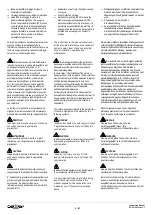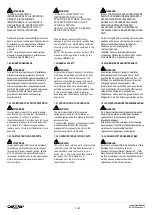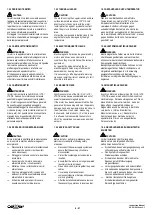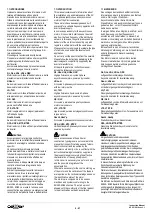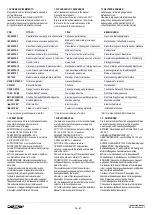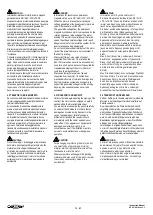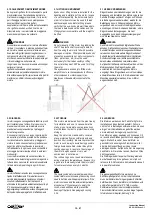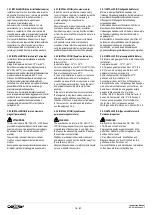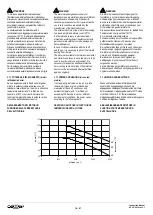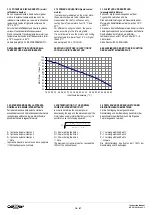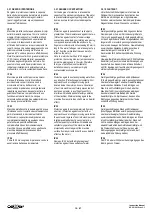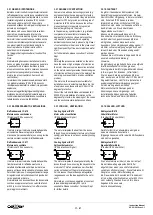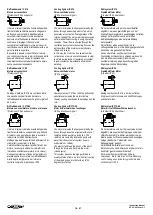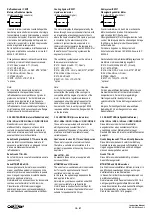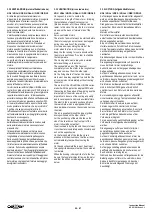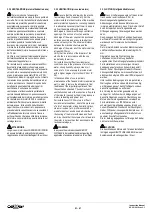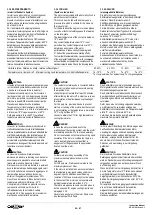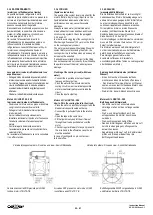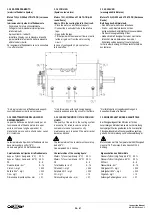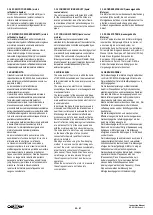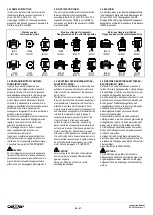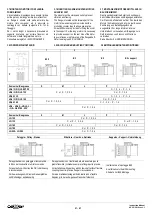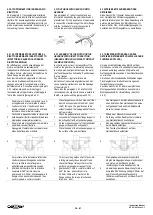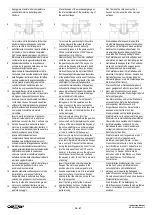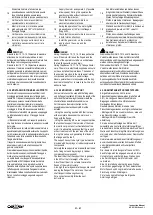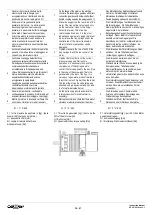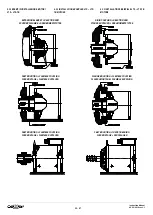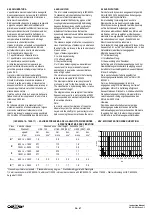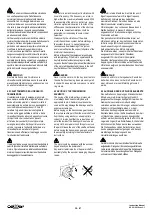
20 - 97
Instruction Manual
AC 02/2019-rev.1.1
3.3.2 VENTILAZIONE (motori raffreddati ad aria)
HQL / HQLa / HQCA / HQLa-Li / QSR / QS/QLS
A richiesta, per contenere le dimensioni
d’ingombro in lunghezza del motore od in seguito
all’applicazione di accessori specifici (freni,
encoder, etc.) la ventilazione può essere radiale.
In questo caso l’elettroventilatore è
posto in alto e
sulla parte posteriore od anteriore del motore.
Motori servoventilati
L’elettroventilatore deve sempre essere messo in
funzione prima dell’alimentazione del motore e
non deve mai essere fermato durante il
funzionamento della macchina. Prevedere un
dispositivo che impedisca
l’avviamento del
motore quando il ventilatore non è in funzione.
Mantenere il ventilatore in funzione per qualche
minuto anche dopo lo spegnimento del motore in
modo da stabilizzare la temperatura.
Le portine di chiusura devono sempre essere
installate pri
ma di procedere all’avviamento del
motore.
L'aria aspirata/soffiata dal ventilatore deve
attraversare completamente lo statore in senso
longitudinale e fuoriuscire dalla parte opposta.
Sullo scudo di fissaggio del ventilatore devono
sempre essere applicate le portine chiuse per
evitare che l'aria entri/fuoriesca immediatamente
senza raffreddare il motore.
I motori della serie HQLa/HQLa-Li/QSRa sono
costruiti con grado di protezione IP 23S e l’aria di
raffreddamento lambisce anche gli avvolgimenti e
la parte in
terna del motore.. E’ indispensabile
accertarsi della qualità dell’aria di raffreddamento
e nel caso richiedere o prevedere opportuni filtri.
Di norma l'elettroventilatore è posto in alto sullo
scudo posteriore del motore che è provvisto di n°
2 portine chiuse per convogliare l'aria di
raffreddamento attraverso lo statore e scaricarla
nell'ambiente tramite le portine grigliate (aperte)
poste sullo scudo opposto
Per l'eventuale posizionamento
dell'elettroventilatore sul lato dello scudo o sulla
parte anteriore del motore è necessario tener
presente che:
l'aria aspirata ed immessa nel motore deve
attraversare completamente lo statore in senso
longitudinale e fuoriuscire dalla parte opposta.
Sullo scudo di fissaggio del ventilatore devono
essere applicate le portine chiuse per evitare che
l'aria fuoriesca immediatamente senza raffreddare
il motore. Sullo scudo opposto devono essere
applicate almeno n° 2 portine grigliate (aperte) per
consentire il deflusso dell'aria di raffreddamento.
Durante la foratura dei coperchi per il fissaggio del
ventilatore evitare che i trucioli penetrino all'interno
del motore e che la punta di foratura danneggi gli
avvolgimenti sottostanti.
3.3.2 VENTILATION (air cooled motors)
HQL / HQLa / HQCA / HQLa-Li / QSR / QS/QLS
On request, in order to contain the
dimensions in length of the motor or following
the installation of specific accessories
(brakes, encoder, etc.)the ventilation can be
radial. In this case, the electric fan is located
up and on the back or forward side of the
motor.
Servo-ventilated motors
The electric fan must always be started before
the motor supply and must never be stopped
during the operation of the machine.
Provide a device avoiding the start of the
motor when the fan is not running.
Keep the fan running for some minutes after
the motor is switched off in order to stabilize
the temperature.
The closing slats must always be installed
before switching on the motor.
The sucked/blown air of the fan must
completely cross the stator in the longitudinal
way and come out from the other side.
On the fixing shield of the fan, the closed
slats must be always applied to avoid that the
air comes in/out immediately without cooling
the motor.
The motors of the HQLa/HQLa-Li/QSRa series
are built with the protection degree IP23S and
the cooling air flows around the winding and the
internal part of the motor as well. It is
imperative to be sure of the cooling air quality
and in case request and provide suitable filters.
The electric fan is normally positioned high on
the rear shield which is equipped with two
closed windows to convey the cooled air across
the stator.
The air is expelled through the (open) grilled
doors positioned on the other shield.
For the positioning of the electric fan on the
side of the shield or on the front part of the
motor it should be noted that:
the air sucked in by the fan onto the motor must
cross the stator completely and horizontally and
exit on the opposite side.
On the fixing shield of the fan the closed
windows must be mounted so that the air does
not immediately leave without cooling the
motor.
On the opposite shield there must be at least
two open grilled windows to allow the cooled air
to circulate.
When the housing is being drilled to fix the fan,
be sure that no metal chips fall inside the motor
and that the drill do not damage the windings
below.
3.3.2 LÜFTUNG (luftgekühlte Motoren)
HQL / HQLa / HQCA / HQLa-Li / QSR / QS/QLS
Auf Verlangen kann eine radialer Lüfter eingesetzt
werden, um die Baulänge zu begrenzen oder für
den Anbau spezifischer Zubehörs (Bremsen,
Drehgeber usw. In diesem Fall ist der Elektrolüfter
oben auf der Rück- oder Vorderseite des Motors
montiert.
Motoren mit Servolüfter
Der Lüfter muss immer laufen bevor der Motor
anläuft und darf niemals während dem Betrieb des
Motors angehalten werden.
Eine Vorrichtung die verhindert, dass der Motor
startet wenn der Lüfter nicht läuft, ist vorzusehen.
Um die Temperatur stabil zu halten, muss der Lüfter
nach der Motorabschaltung einige Minuten
nachlaufen.
Die Abdeckungen müssen immer vor dem Start des
Motors montiert sein.
Die angesaugte/ausgedrückte Luft des Lüfters
muss der Stator immer komplett längs
durchströmen und auf der gegenüberliegenden
Seite austreten.
Auf dem Ventilatorgehäuse müssen immer die
geschlossenen Abdeckungen montiert sein, um zu
verhindern, dass Luft angesaugt oder ausgedrückt
wird ohne den Motor zu kühlen.
Die Motoren der Baureihen HQLa/HQLa-Li/QSRa
sind in Schutzart IP23S gebaut, die Kühlluft
umströmt auch den Rotor und die Innenteile des
Motors.
Es ist unabdingbar eine geeignete Luftqualität
sicherzustellen oder ggf. entsprechende Filter zu
verlangen oder vorzusehen.
Der Elektrolüfter ist normalerweise auf dem
hinteren Lagerschild montiert und mit zwei
geschlossen Abdeckungen versehen. Somit wird
der Luftstrom durch den Motor mit Luftaustritt
durch die geöffneten Abdeckbleche auf der
Vorderseite ermöglicht.
Für eine eventuelle seitliche Montage oder auf der
Vorderseite muss folgendes berücksichtigt
werden:
Die angesaugte Luft muss den Motor immer
komplett längs durchströmen und auf der
gegenüberliegenden Seite austreten.
Auf dem Ventilatorgehäuse müssen immer die
geschlossenen Abdeckungen montiert sein, um zu
verhindern, dass Luft angesaugt oder ausgedrückt
wird ohne den Motor zu kühlen.
Auf der gegenüberliegenden Seite müssen die
geöffneten Abdeckbleche montiert werden, um
den Kühlstrom zu ermöglichen.
Während des Bohrens des Lüftergehäuses für die
Befestigung des Lüfters ist zu verhindern, dass
Späne in den Motor gelangen und, dass der
Bohrer die darunterliegende Wicklung nicht
beschädigt.

